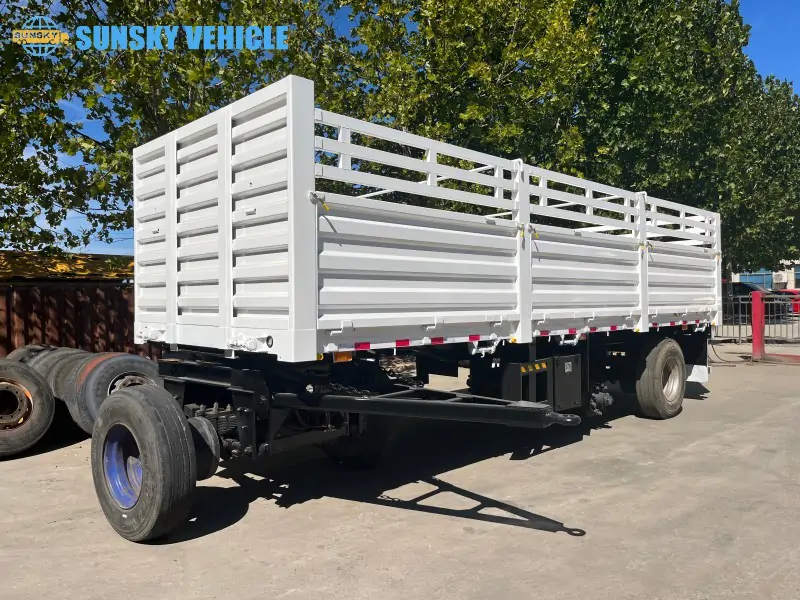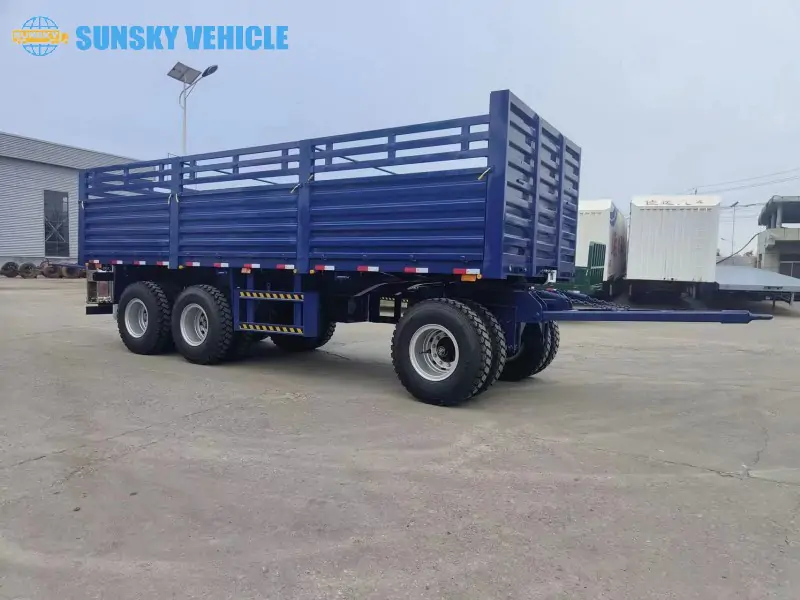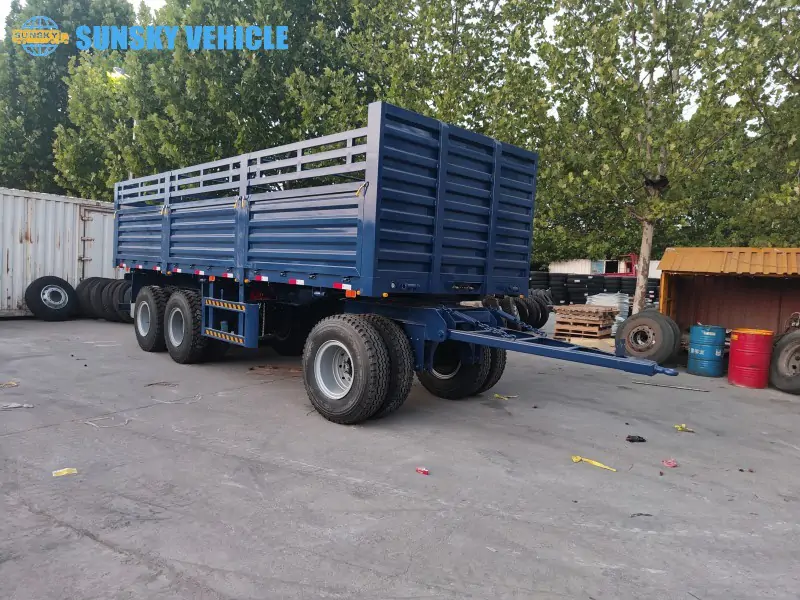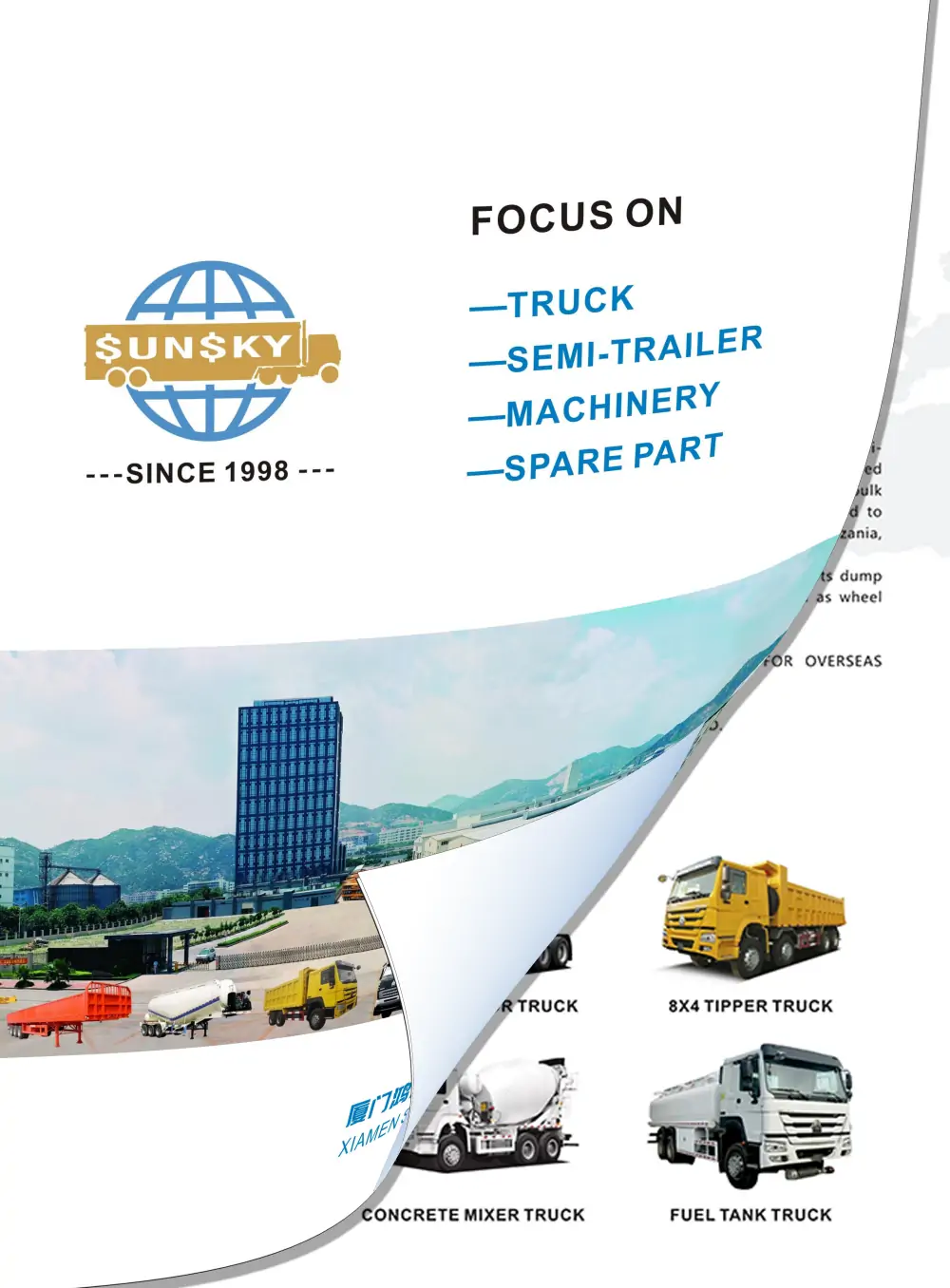Introduction
In the world of modern logistics and freight transport, efficiency and versatility are everything. As global trade and industrial operations expand, transport fleets rely on a variety of trailer types to move goods safely and cost-effectively. From flatbed trailers to low bed trailers, and from tipper trailers to tankers, each design serves a specific purpose.
Among these, one type often raises questions: the drawbar trailer.
What exactly is a drawbar trailer, and how does it differ from a semi trailer?
This article explores:
- The definition and structure of a drawbar trailer
- How it works in real-world applications
- A detailed comparison with semi trailers
- Practical advantages, limitations, and maintenance tips
- Guidance on choosing the right trailer type
By the end, you’ll understand how drawbar trailers fit into modern logistics and whether they’re suitable for your transport needs.
Definition: What Is a Drawbar Trailer?
A drawbar trailer—also known as a full trailer—is a self-supporting transport trailer designed with both front and rear axles. Unlike semi trailers, which rely on the tractor unit (prime mover) to support part of their load through a fifth-wheel coupling, a drawbar trailer carries its entire weight on its own axles.
At the front, it connects to the towing vehicle using a drawbar or tow bar—a rigid, pivoting linkage that allows for steering movement while maintaining a secure mechanical connection. This setup gives the trailer excellent stability and maneuverability when properly balanced.
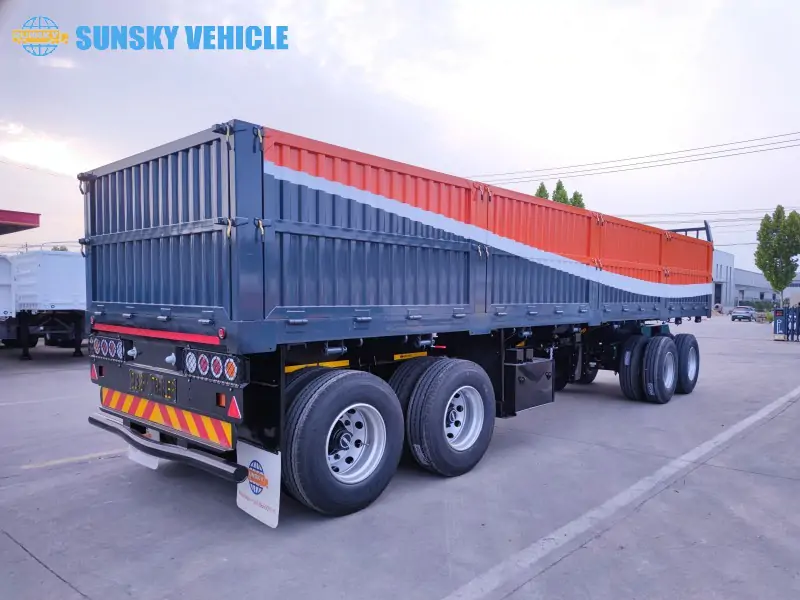
Key Difference from a Semi Trailer:
-
A semi trailer transfers a portion of its load weight to the tractor through the fifth wheel coupling.
-
A drawbar trailer, however, uses a drawbar coupling and remains fully supported by its own wheels, meaning it doesn’t rely on the truck for load-bearing.
Common Terms You May Encounter:
-
Drawbar trailer / Full trailer – standard terminology for a trailer with front and rear axles.
-
Dog trailer – commonly used in Australia; refers to a smaller drawbar trailer pulled behind another trailer or truck.
-
A-train – a configuration where a single drawbar trailer is connected to a truck.
-
B-train – a double-trailer configuration using a fifth-wheel connection on the lead trailer.
This distinction is fundamental in the transport industry because it influences how cargo is distributed, what type of coupling is required, and how the vehicle behaves on the road.
Key Components & Structure
A drawbar trailer is engineered with a distinctive configuration that allows it to operate independently while maintaining safe and efficient towing performance. Each component plays a crucial role in ensuring stability, maneuverability, and durability under heavy-duty transport conditions.
1. Drawbar (Towing Arm)
The drawbar is the defining component of a drawbar trailer. It’s a rigid steel bar or A-frame structure that connects the trailer to the towing vehicle.
-
Designed to handle high tensile and torsional forces, ensuring safe operation even during tight turns.
-
Some designs include adjustable drawbars, allowing compatibility with different truck heights.
2. Drawbar Eye & Coupling System
At the front end of the drawbar is the drawbar eye, a circular steel ring that hooks onto the coupling device (usually a pintle hook or towing hitch) on the towing truck.
-
This mechanical coupling allows for flexible movement and absorbs vibration during transport.
-
Heavy-duty coupling systems include air, hydraulic, and electrical connectors to synchronize braking and lighting with the towing vehicle.
3. Axles & Suspension
Drawbar trailers are equipped with both front and rear axles, making them self-supporting.
-
The front axle often features a swivel or steering mechanism, improving turning radius and maneuverability.
-
The rear axle provides stability and weight distribution.
-
Suspension options include leaf spring, air suspension, or mechanical suspension, chosen based on load type and road conditions.
4. Braking & Lighting Systems
Safety and regulatory compliance are ensured through integrated air braking systems that connect to the towing truck’s control system.
-
The brake lines and electrical connectors synchronize the trailer’s response with the prime mover.
-
LED lighting systems ensure visibility, especially for long-haul or night transport operations.
5. Frame & Chassis Reinforcement
The chassis is the main load-bearing structure. Built from high-strength steel, it is reinforced with cross members and longitudinal beams to prevent deformation under heavy loads.
-
Proper chassis design ensures even load distribution across both axles, minimizing wear and improving safety.
6. Swivel / Steering Front Axle
One of the most unique features of a drawbar trailer is the steering front axle assembly.
-
-
It allows the front wheels to pivot with the towing vehicle, making turns smoother and tighter than rigid axle configurations.
-
This feature is essential for urban logistics or construction sites where space is limited.
-
How Does a Drawbar Trailer Work?
The working principle of a drawbar trailer is based on an independent load-bearing design that allows it to be towed safely and efficiently by a truck or another trailer. Instead of relying on the towing vehicle to support its front weight, a drawbar trailer uses its own front and rear axles to maintain balance and load stability during transport.
1. Coupling and Power Transmission
A drawbar trailer connects to the towing vehicle via a drawbar linkage system — typically using an eye bolt and pin or a ring-and-hook coupling.
-
The towing truck provides all the pulling power, while the trailer’s drawbar transmits this force to the chassis.
-
The connection allows limited movement in both vertical and horizontal directions, which helps absorb road shocks and articulation over uneven terrain.
2. Self-Supporting Load Structure
Unlike a semi trailer, where part of the load is carried by the tractor’s fifth wheel, a drawbar trailer carries 100% of its load on its own axles.
-
The front and rear axles evenly distribute the load, improving road stability.
-
This design makes the trailer ideal for long-distance or multi-trailer combinations, as it reduces pressure on the towing vehicle.
3. Steering Mechanism
The front axle of a drawbar trailer is designed with a swivel or steering system, allowing it to pivot in coordination with the towing truck.
-
This enables the trailer to follow the same turning path as the towing vehicle, which improves maneuverability.
-
On narrow roads or construction sites, this system significantly reduces turning radius and tire wear.
4. Drawbar Length and Handling
The length of the drawbar plays a crucial role in handling and stability:
-
A longer drawbar provides greater stability at high speeds but requires more space for turning.
-
A shorter drawbar offers tighter maneuverability but may reduce stability under heavy loads or during braking.
Finding the right balance is essential for safe operation, especially in combination (A-train or B-train) setups.
5. Braking Synchronization and Safety
Drawbar trailers use air or hydraulic braking systems connected to the towing vehicle’s main system.
-
This ensures that the trailer brakes engage simultaneously with the truck, maintaining balanced deceleration.
-
Advanced systems also include anti-lock braking (ABS) and electrical connectors for synchronized lighting, enhancing road safety.
Drawbar Trailer vs Semi Trailer — Key Differences
When selecting the right trailer for your transport operations, understanding the differences between drawbar trailers and semi trailers is essential. Although both serve similar hauling purposes, their mechanical structure, coupling method, and operational performance are distinct — each suited to different environments and transport needs.
| Feature | Drawbar Trailer | Semi Trailer |
|---|---|---|
| Axle Layout | Front & rear axles (self-supporting) | No front axle (partially supported by truck) |
| Connection Type | Drawbar eye + hook coupling | Kingpin + fifth wheel coupling |
| Load Support | Independent | Shared with tractor |
| Maneuverability | Better for narrow/tight roads | Easier on highways |
| Detachment | Quick hook/unhook | Requires fifth wheel disconnect |
| Regulations | Classified as full trailer | Standard semi-trailer category |
| Use Cases | Short distance, industrial, agriculture | Long-haul freight, logistics |
| Stability | Very stable at low speed | More stable at high speed |
In short:
-
A drawbar trailer is ideal for short-distance, heavy-load, or low-speed operations, such as in construction sites, mining areas, and agricultural logistics. Its flexible steering system makes it perfect for tight environments.
-
A semi trailer, on the other hand, dominates long-distance highway transport due to its better aerodynamics, fuel efficiency, and ease of fleet standardization.
-
However, the overall length of a drawbar combination is usually longer, which can make it subject to stricter road regulations and turning limits in certain countries.
Applications & Use Cases
Because of their self-supporting design, strong load-bearing capacity, and flexible steering, drawbar trailers are widely used across industries that demand short- to medium-distance hauling, multi-site logistics, and heavy material movement. Below are the key application sectors where drawbar trailers offer distinct advantages:
Construction Industry
In the construction and infrastructure sector, drawbar trailers are ideal for transporting concrete blocks, steel bars, prefabricated panels, and construction equipment.
-
Their strong chassis and front-axle steering system allow easy navigation through tight job sites and uneven terrain.
-
The quick coupling system also makes them perfect for frequent loading and unloading, saving time on-site.
Agriculture
Drawbar trailers are a staple in agricultural logistics, often seen behind tractors or medium-duty trucks.
-
Common uses include grain, feed, fertilizer, and agricultural machinery transport.
-
Their ability to operate smoothly on unpaved or rural roads makes them essential for farm-to-warehouse delivery cycles.
-
Many farmers prefer multi-trailer combinations (A-trains or dog trailers) for high-volume seasonal hauling.
Mining & Industrial Operations
In mining and heavy industry, durability and load stability are crucial — and drawbar trailers meet these demands well.
-
They are used for hauling raw materials, heavy machinery, spare parts, and processed ores within or between industrial sites.
-
The self-supporting axles provide better weight distribution, reducing wear on the towing vehicle and improving operational efficiency.
Local Logistics & Municipal Transport
Municipal services and local logistics fleets use drawbar trailers for urban waste collection, building debris removal, and equipment transport.
-
Their short turning radius and easy detachment make them especially suited for city operations and restricted access areas.
-
In many cases, low-speed, high-frequency transport tasks — such as waste transfer or material shuttling — are best handled with this trailer type.
Overall, the drawbar trailer’s versatility and adaptability make it a go-to choice in sectors that require frequent maneuvering, multiple stops, or operation in confined spaces — offering a balance between payload efficiency and operational flexibility.
Understanding the strengths and weaknesses of drawbar trailers is essential for operators and fleet managers when deciding the right trailer for specific transport tasks. Drawbar trailers have both front and rear axles, which makes them fully self-supporting. This design provides excellent stability when carrying heavy loads, especially at low speeds or on uneven surfaces. The detachable drawbar and simple coupling system allow for quick hook/unhook operations. Maintenance is straightforward because most components, like axles, suspension, and braking systems, are independently accessible. The swivel or steering front axle enables smooth turns in narrow roads, construction sites, and urban areas. This makes drawbar trailers ideal for short-distance transport with frequent stops or multi-trailer combinations. Drawbar trailers, especially when used in A-train or B-train configurations, have a longer combined length, which increases the turning radius. Drivers need to account for space requirements during maneuvering. While highly stable at low speeds, drawbar trailers are less efficient for long-distance highway transport compared to semi trailers. Their aerodynamic profile and handling characteristics limit fuel efficiency and highway speed performance. The additional front axle, drawbar mechanism, and reinforced chassis make drawbar trailers slightly more expensive upfront. However, this cost can be justified by their durability and versatility in heavy-duty applications. Overall, drawbar trailers are best suited for short- to medium-distance hauling, heavy loads, and operations requiring maneuverability in tight or uneven environments, while semi trailers remain the preferred choice for high-speed, long-haul freight.
Selecting the appropriate trailer is crucial for efficient operations, safety, and cost-effectiveness. Here’s a practical guide to help determine whether a drawbar trailer or a semi trailer is the better choice for your needs: Heavy or oversized loads that require stable, self-supporting trailers are ideal for drawbar trailers. Standard cargo, containers, or frequent high-volume shipments are better suited for semi trailers due to their high-speed efficiency. Long-distance highway transport favors semi trailers because of their aerodynamic design and compatibility with highway regulations. Short-distance, industrial, or rural transport, where roads may be narrow or uneven, is better handled by drawbar trailers. Drawbar trailers require trucks with suitable coupling points and drawbar height. Semi trailers need a tractor with a fifth wheel to support the load. Some regions have length, axle load, or combination restrictions that impact trailer choice. Drawbar trailers may have higher upfront costs but can be more versatile in heavy-duty applications. Consider the maintenance requirements: drawbar trailers are mechanically simpler in some areas but may require more checks on the drawbar assembly and steering axle. Summary: Use a semi trailer for long-haul, high-frequency container transport. Choose a drawbar trailer for short-haul, heavy, oversized, or specialized cargo, especially when maneuverability is critical. Start your project today and get a high-performance semi-trailer solution tailored specifically to your unique needs. Proper maintenance and safety practices are essential to ensure that drawbar trailers remain reliable, efficient, and compliant with transport regulations. Regular checks also reduce the risk of accidents and prolong the trailer’s service life. Regularly examine the drawbar eye, pin, and coupling hooks for wear, cracks, or deformation. Ensure all fasteners and mounting points are secure. Lubricate moving parts where necessary to prevent friction-related damage. Inspect front and rear axles for proper alignment and signs of stress. Monitor wheel bearings for smooth rotation; replace if necessary. Verify that the suspension system (leaf springs or air suspension) is functioning properly. Test air or hydraulic brakes frequently to ensure synchronized operation with the towing vehicle. Inspect all lights, indicators, and electrical connectors to comply with local regulations. Replace worn brake pads, hoses, or connectors promptly. Ensure the drawbar length adheres to regional transport laws regarding trailer combinations. Longer drawbars require careful attention to turning radius and clearance. Train drivers on hooking/unhooking procedures, especially for multi-trailer setups. Provide guidance for reversing, sharp turns, and obstacle navigation. Encourage regular safety audits to reduce risks during heavy-load or urban transport. Following these maintenance and safety practices ensures consistent performance, reduces the likelihood of breakdowns, and keeps both drivers and cargo safe.
Here are some commonly asked questions about drawbar trailers, helping operators and fleet managers make informed decisions: A drawbar trailer has both front and rear axles and is self-supporting, connecting to the towing vehicle via a drawbar. A semi trailer relies on the tractor’s fifth wheel to support the front portion of the load and is typically used for long-haul freight. Load capacity depends on axle configuration, suspension, and chassis strength. Drawbar trailers are ideal for heavy, oversized, or specialized loads, particularly for short-distance, low-speed operations. Semi trailers are optimized for high-speed, highway transport and standard cargo. Depending on the country and trailer weight, a specific commercial vehicle license or endorsement may be required. Multi-trailer combinations (A-train, B-train) often require advanced driver certification. Most drawbar trailers use eye-and-hook or pin-and-ring couplings. Some specialized industrial trailers may include custom heavy-duty couplings for enhanced stability. Regular inspections are recommended, ideally before each trip for heavy-duty operations. Scheduled maintenance should include checks on drawbar eye, pins, couplings, axles, and suspension. This ensures safety, legal compliance, and operational reliability. In summary, a drawbar trailer is a self-supporting, versatile transport solution designed with both front and rear axles, connected to a towing vehicle via a drawbar. Unlike semi trailers, which rely on the tractor to bear part of the load, drawbar trailers carry their own weight, offering enhanced stability and maneuverability in short-distance, heavy-load, or industrial applications. When choosing the right trailer, consider: Transport distance – long-haul vs short-haul operations. Cargo type – standard containers vs heavy or oversized machinery. Operating environment – highway, urban, industrial, or rural settings.Advantages & Limitations
Advantages
Self-Supporting Stability
Ease of Operation and Maintenance
Flexible Steering for Tight Spaces
Limitations
Longer Overall Length
Not Ideal for High-Speed Long Hauls
Higher Cost Compared to Standard Semi Trailers
How to Choose the Right Trailer Type
1. Consider the Cargo Type, Weight, and Transport Frequency
2. Evaluate Transport Distance and Route Conditions
3. Check Compatibility with Towing Vehicle
4. Account for Regulations, Budget, and Maintenance
Robust and Durable, Achieve Exceptional Transport
Maintenance & Safety Tips
1. Inspect the Drawbar and Coupling Components
2. Check Axles and Bearings
3. Braking and Lighting Systems
4. Verify Drawbar Length and Legal Compliance
5. Driver Training and Safe Operation
FAQs
1. What is the difference between a drawbar trailer and a semi trailer?
2. Can a drawbar trailer carry more load than a semi trailer?
3. Do drawbar trailers require special driving licenses?
4. What coupling types are used for drawbar trailers?
5. How often should the drawbar be inspected?
Conclusion

